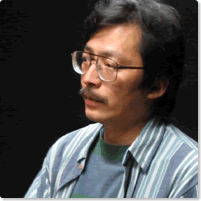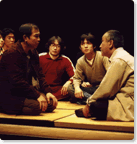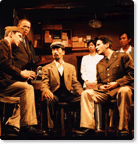- “A Freedom that Rocks the Boat”—an interview with Yoji Sakate
by Roger Pulvers - We met in the little space virtually under the elevated railroad tracks at Umegaoka—appropriately called “The Box”—in which “The Attic” was performed. The set had been dismantled for dispatching to the U.S. tour beginning the next week. Yoji Sakate himself was making preparations to depart for the tour’s first venue in Florida. This is what he told me…
- I think I approach a narrative in a slightly different way from most other playwrights. I don’t start with a character, put him or her in a story and program the whole thing together. Life to me is more complex than that. Imposing stories on people takes away from my freedom to portray them as I wish. I do have a moral to the story in a play, I suppose, but that is for the audience to decide on after they have seen the play.
So where do the characters get their meaning from, if not directly from the narrative? The primary mechanism for this in theater is the “act of recognition,” which, in short, comes from words. “This person is a human being.” That can only be seen on stage by virtue of the things they say or the things that are said about them. There may be abstract concepts in drama, but I’m just not interested in them. When playwrights strive to assert some abstract concept in a play their intentions become all too visible. They supercede the drama. It all looks too deliberate. My method is to break the whole numbers of drama into factors as much as I can. Let me explain.
I am most intrigued, and have been for as long as I can remember, with the process of transposition, that is, substitution or transformation. What I mean is, an actor playing one character and then becoming another, a person being transported, as it were, into the body of another or into some other thing. And to me it is language that gives actors this cognition, this understanding, the knowledge to do this. Language is the function that frees the actor to explore the possibilities of characters.
Some people might feel this to be a bit anomalous. But this process, of transformation, is at the heart of traditional Japanese theater. In that sense, I am fascinated by Zeami’s “Fukushiki Mugen Noh” style in which you have a meeting of dream and reality. He is still relevant to us today. He is motivated by this consciousness. I wrote my graduation thesis on Zeami. Actually, I must add that I’ve only seen about 10 Noh plays in my life and that I’m really not much attracted to the Noh theater. It’s Zeami’s ideas that move me.
Look, for instance, at apparitions, departed spirits, ghosts in that tradition. This coffee cup in front of me may be my own departed spirit. So, in a way, I may be this cup and it may be me. Which is real? Which is the live representation…which is the apparition? This notion, to me, is the basis of theater. By encountering an apparition we realize that there are two illusions on stage. The expression of this confirms what is theatrical, and that’s what I aim for on stage. This is different from what virtually all western theater, as it has come to Japan, aims for. Those practitioners have their own systems and aims as well, of course. But I am striving to express something different, through words, physical sensations and gestures.
I was born and brought up in Okayama, far from the cultural centers of Japan. There were only four movie houses in my town and we hardly got to see any theater. Up till the time I was 18, I never dreamt that I would someday be a playwright. The first real play that I saw was Ibsen’s Hedda Gabbler at the Haiyuza Theater in Roppongi, Tokyo. I thought, “Why are there so many old people in this play?” Then I saw Kohei Tsuka’s Murder Incident at Atami and was very impressed. I ended up working with Tetsu Yamazaki, but left there and eventually formed my own troupe, “Rinkogun.”
The “rinko” in Rinkogun means “phosphorescence,” but I chose it because I just liked the sound and decided to stick with it. Later on I read in something written by Lafcadio Hearn, where Hearn saw light on the sea in the distance, referring to it as a kind of phosphorescent light. Hearn said something to the effect that while by the sea he felt that he too was just a point of phosphorescent light when seen from space. Here again I saw someone, Hearn in the case, transposing himself into this light and the light on the waves becoming him. I found this part very theatrical. But this hadn’t been in my thoughts when I took the name for my theater.
I guess I was more of a movie kid. I formed a movie club in high school with some friends just so that I could see the movies that I wouldn’t normally see. Actually, I made three films while in high school. One was a crummy one about somebody who was running, just running. After all, I was in the track club at school, and the two clubs sort of ran together. Another film was set on an uninhabited island where these guys have to live in isolation from the outside world and are sent tinned mackerel in miso from a helicopter. They’re stuck on the island. As a matter of fact, this film was shown at the Pia Film Festival, which ran a competition for amateur 8mm films in the ’80s.
When I come to think about it, I’ve always been interested in the theme of isolation and of being closed in somewhere. I loved the film Hell in the Pacific, where Toshiro Mifune and Lee Marvin are the only people there and the drama unfolds between them alone. The secret room, the hidden closet…this intrigues me. I directed the Japanese version of an American play, CVR, which is about a cockpit voice recorder, about the cooped up space of the cockpit. I even went into a flight simulator cockpit once to see what it was like. I really go for that sort of thing, as you can see from “The Attic.”
Once I had formed the company…and this may sound strange…I felt that the company came first, theater itself second. We are a body, a group, a small community. The experiments of this community are theater, and things like the Japanese language and religious consciousness are expressed on the stage as experiments of this community.
Let me return for a minute to apparitions. Please don’t get me wrong, I don’t believe in the soul. I have no religion whatsoever. But this has become my way to get into the world, just as it was, I believe, for Zeami. It is important for me that things become transformed, that characters are transposed. We Japanese always take things without changing them. Someone tells us to do something and we follow it to the letter. Even the leftists do this. They are dogmatic and tend to turn their ideology into a kind of little emperor system. This is a terrible trait.
I have dealt with many social issues in Japan, and some outside Japan. These include the death penalty, whaling, American bases on Okinawa, and the war in Iraq, to name a few. When I read the paper I get incensed like anyone else. But the media in Japan are silent about so many vital issues and it often makes me angry to watch. And so are the Japanese people. Take the American bases on Okinawa. There used to be protest there about them, but now there are even young people who think it is cool that the Americans are there. The media exacerbates this problem by ignoring it and so do the people. I think about these problems through my plays and I am going to continue to write works about problems like these. I am now writing a play, for production in 2006 or 2007, based on Hiroshi Muneta’s book, Dear Mr. Emperor (Haikei Tenno Heikasama), about a rather slow fellow who becomes a soldier and thinks, “Hey, geez, this is great. I get to eat for free and get money doing this too.”
There have been antiwar Self-Defense Forces soldiers who were against the war in Vietnam or the Gulf War and have actually brought cases against the Self-Defense Forces. But the media won’t touch this sort of thing. Based on this type of problem, last year in Nagoya I put on a play about an antiwar soldier, Nobutaka Watanabe. He was actually taken hostage in Iraq, and I was corresponding with him before then. About half of the play is based on his experiences. Well, the production was partially subsidized by the ward in Nagoya where the theater was. When the authorities in Nagoya found out about the content of the play, they withdrew their support. Only one national newspaper took up the issue. This is a matter of freedom of speech. But no one else would touch the story.
Japan was always like this, but it’s getting worse. For example, concerning opposition to the death penalty, there’s very little here and the press rarely writes it up. Last year there was an important law passed in the area of criminal law (the average 20-year term after which most prisoners serving life sentences have been released from prison in Japan was raised to 30 years) but there was almost no media coverage of that. Last year I wrote a play, Blind Touch, modeled on a man named Fumiaki Hoshino, a political prisoner who was arrested on trumped up charges and has been in prison for 34 years. But we never see media coverage of the problem of how the time actually served for life sentences can be arbitrarily decided within the penal system.
Sometimes I don’t know why I have to do this all by myself with my plays. I’m certainly not enough by myself. We need more people to take these things up. If you ask me whether or not there is freedom in Japan, I would have to say that I really don’t know. The Japanese people are all holding their breath. They cannot exhale, they cannot express themselves. The young Japanese girl in “The Attic” says that she envies Anne Frank’s freedom. Anne Frank, she says, was overjoyed when she heard about the plan to assassinate Hitler. “I,” she adds, “am looking forward to watching a television serial drama.”
I don’t know whether freedom really gives people the right choices or the wisdom to opt for them. We Japanese always give in to the prevailing customs of the time. We opt for freedom that doesn’t rock the boat.
Review
JUST BELOW THE ROOF OF THE SKY — Yoji Sakate’s The Attic (→“Play of the Month”)
by Roger Pulvers
In a moving passage the young girl who has locked herself up in her own personal attic speaks of Anne Frank. The young girl, presumably living in present-day Japan, can choose to do what she likes with her life, unlike Anne Frank. And yet she envies Anne Frank’s freedom. She asks herself, and us in the process, what freedom is.
It is in scenes like this that “The Attic” soars. It becomes a vehicle for introspection that we all ride in. In that sense, the young girl who is holed up in her attic as well as the young man who makes the same choice are more aware of society’s pitfalls and traps than those “free people” who come to save them.
The space itself is an ingenious device. It is literally a hole in the wall. Yet Sakate as director uses this with great skill, giving it a flexibility that is sometimes quite startling. Being an attic it is just below the roof. But, at various times during the play, it is underground, at the very top of the sky (yet when the young man’s brother jumps out he is on terra firma), in what appears to be a dugout during a war and so on. The attic suddenly becomes a womb when a character tells us that a fetus is a kind of hikikomori.
This word, hikikomori, is pivotal to the play. It refers to the young Japanese people who withdraw from society and hole up in a room, usually in their parents’ home. But it is clear from the beginning that Sakate is much more than a social commentator on contemporary Japanese mores. On one occasion the young girl’s teacher comes to visit her, presumably to persuade her to give up her voluntary isolation and return to school. But, in this scene which turns into a hilarious comment on the level of bullying in adult society, the teacher, all choked up, begs forgiveness from the young girl and expresses the desire herself to be shut off from the outside.
Other scenes which display what has come to be thought of as a most unJapanese black humor involve the young man’s over-protective mother, who, it appears, prefers her son to be near her even if it means that he is seriously disturbed and agoraphobic; two detectives who long to see themselves as characters in a television police drama; a virtually homeless family that lives in a cardboard “attic”; news reports from 2023; a mountain retreat in a blizzard; the attic-as-coffin, where the dead young man hams it up to great comic effect; the attic as stage for a parody of a jidaigeki, or samurai drama (the samurai can’t draw their swords for lack of room!)…in other words, Sakate’s attic is a microcosm of Japanese society in the first instance and, by clear implication, of life in our time.
Sakate’s manipulation of the space through the use of sound and light is brilliantly inventive. Each region occupied by the attic, whether physical or mental, is clarified in our mind by light and sound, defining the space and its purpose in the scene.
The cast’s physical and vocal work is equally brilliant. As an ensemble they work with an amazing unity in style and rhythm, with very clear yet not overly mannered gestures that go further to defining the attic that they find themselves in. Their physical discipline reminded me of what I saw many years ago in Wroclaw in Jerzy Grotowski’s theater.
Sakate reaches far out of Japan with this play. He is equally at home in portraying kitsch Japanese TV-screen types as he is historical figures such as Kaspar Hauser, who, like Anne Frank, was kept isolated from the outside world involuntarily. When the young girl visited by her teacher turns her little bedside lamp into a planetarium projector and the entire theater is flooded in stars, we realize that Sakate’s attic can take us anywhere our imagination allows it to.
He combines the wacky with the arch-serious, the mundane with the lyrical: in one of two beautiful monologues we are told that “the dream just continues on…it never ends….” And we finally come to learn that the object that the young man who committed suicide in his attic held in his hands was not a weapon, a stick or a pole, but a paintbrush. If Sakate’s attic is everyplace, then the young artist’s portrait, left on the attic’s wall--just as people left drawings on the walls of caves tens of thousands of years ago--is of everyperson.
Sakate’s “The Attic” is universal in more ways than one.







